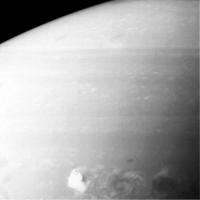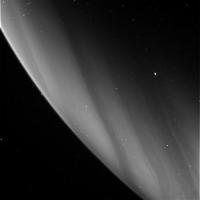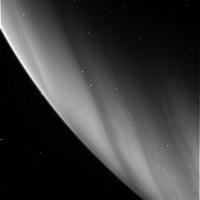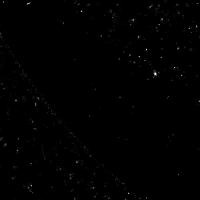Printable Version of Topic
Click here to view this topic in its original format
Unmanned Spaceflight.com _ Cassini general discussion and science results _ Southern Storm
Posted by: SigurRosFan Feb 14 2006, 06:14 PM
Amateur photo:
--- The storm's north-south dimension is about 3,500 kilometers (2,175 miles); it is located at minus 36 degrees (planetocentric) latitude and 168 degrees west longitude. ---
Cassini (reprojected view):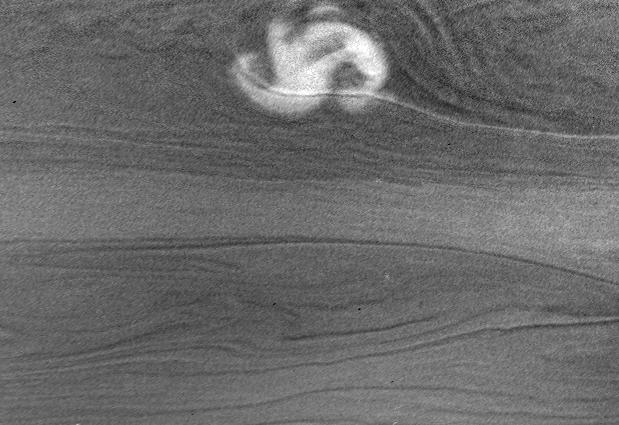
- http://photojournal.jpl.nasa.gov/catalog/PIA07789 - Storm at Night (Reprojected View)
- http://photojournal.jpl.nasa.gov/catalog/PIA07788 - Storm at Night (Limb View)
- http://photojournal.jpl.nasa.gov/catalog/PIA02166 - Lightning Sounds from Saturn (Audio)
Posted by: ljk4-1 Feb 14 2006, 06:58 PM
Glad to know that Cassini is finally studying it! Rather unusual looking
storm structure, or at least it seems so for us Earth-bound creatures.
An earlier discussion and collection of amateur images of the storm
may be found here:
http://www.unmannedspaceflight.com/index.php?s=&showtopic=1963&view=findpost&p=38755
Posted by: SigurRosFan Feb 15 2006, 09:39 AM
Dragon Storm part two?
--- The storm is in a similar location to the "Dragon" storm reported last year - http://antwrp.gsfc.nasa.gov/apod/ap050225.html - so it may be a reemergence of that storm or a new storm.
According to the RPWS data, the new storm is generating lightning flashes several times more frequently than the original Dragon storm, and the lightning is as much as five times stronger. At approximately the size of the continental U.S., the storm dwarfs terrestrial thunderstorms. Apparently, it is much fiercer as well -- radio signals from its lightning are more than 1,000 times greater than similar radio static from terrestrial storms. ---
- http://www.nasa.gov/vision/universe/solarsystem/Saturn_storm.html - Volunteers Help NASA Track Return of the Dragon
- http://spaceflightnow.com/cassini/060214lightning.html - Cassini orbiter listens to lightning storm on Saturn
Posted by: deglr6328 Feb 15 2006, 09:52 AM
First thought: OH NOES!! Second thought after opening: Ohhhh Saturn!
![]()
Topic title is quite alarming if you don't read the fourm location first!
Posted by: ljk4-1 Feb 15 2006, 06:26 PM
Science/Astronomy:
* Biggest Lightning Storm Ever Recorded on Saturn
http://www.space.com/scienceastronomy/060214_saturn_lightning.html
Scientists are tracking the strongest lighting storm ever detected at Saturn.
The storm is larger than the continental United States, with electrical activity
1,000 times stronger than the lightning on Earth.
Posted by: Sunspot Feb 17 2006, 06:47 PM
I think this could be another shot of it:
http://saturn.jpl.nasa.gov/multimedia/images/raw/raw-images-details.cfm?feiImageID=63378
Posted by: JTN Feb 19 2006, 10:29 PM
Quoting from the discussion in the http://www.unmannedspaceflight.com/index.php?showtopic=1963&pid=41233&st=0&#entry41233:
Limited attitude control fuel is probably what will end Cassini's lifetime, so every pointing action cuts into the lifetime. But one act of pointing wouldn't be a huge expenditure.
For imaging a large storm on Saturn, there should be plenty of time during near-apoapsis to do so. The schedule at periapsis would be more crowded.
Apart from the physical constraints like fuel, how fast can the mission team react?
The sequences can be and are developed months and years in advance (or so it seems from the Significant Events reports) because the trajectories are fairly predictable, and I get the impression that this is a fairly drawn-out process (possibly it's just relaxed).
If something unexpected leads to a new plan, how quickly can they crank the handle and turn that into new instructions executing on the spacecraft? Is there slack built in to the sequences (e.g., near apoapsis, as you suggest) which could be used to perform new observations without disturbing the existing plan?
(elakdawalla has explained the difficulties of this particular case well in her http://www.planetary.org/blog/article/00000460/, but I'm interested in the general case. How fast could they react if, I dunno, Mimas turned unexpectedly pink?)
Posted by: Sunspot Feb 20 2006, 09:45 AM
http://saturn.jpl.nasa.gov/multimedia/images/raw/raw-images-details.cfm?feiImageID=63537
Another nice view
Posted by: dilo Feb 20 2006, 09:50 PM
http://saturn.jpl.nasa.gov/multimedia/images/raw/raw-images-details.cfm?feiImageID=63378
Made a little bit manipulation in order to better contrast the features... this storm is very impressive and appear elevated from sourronding clouds; look also to this spiral structure at the right of the bright patch!
Posted by: ljk4-1 Apr 7 2006, 03:26 PM
The Storm Rages On
Thu, 30 Mar 2006 - This Cassini photograph shows half of Saturn shrouded in shadow, with its moon Tethys hanging in the foreground. A gigantic storm that was first sighted in January 2006 continues to rage in Saturn's southern hemisphere. This image was taken on February 18, 2006, when Cassini was 2.8 million kilometers (1.7 million miles) from Saturn.
http://www.universetoday.com/am/publish/saturnian_storm_continues.html?3032006
Posted by: ljk4-1 Apr 19 2006, 03:08 PM
Saturn's Speedy Spin Sparks Spectacular Storms
http://www.spacedaily.com/reports/Saturns_Speedy_Spin_Sparks_Spectacular_Storms.html
Cassini Controllers Overcome Software Glitch
http://www.spacedaily.com/reports/Cassini_Controllers_Overcome_Software_Glitch.html
Posted by: ljk4-1 Apr 20 2006, 11:40 AM
SATURN DAILY
- Saturn Storms Dwarf Earth Hurricanes In Size And Longevity
http://www.spacedaily.com/reports/Saturn_Storms_Dwarf_Earth_Hurricanes_In_Size_And_Longevity.html
Pasadena CA (SPX) Apr 20, 2006 - Viewed from space, hurricanes on Earth and the
huge atmospheric disturbances observed on Saturn look similar, but their
differences are greater, offering intriguing insights into the inner workings of
the ringed world currently being investigated by NASA's Cassini spacecraft.
Posted by: dilo Apr 21 2006, 05:40 AM
Looking to the last raw Cassini images of Saturn atmosphere, I was intrigued by the presence of many bright spot apparently located only in the planet, especially close to terminator and more visible in the longer-exposure MT3 filtered images; absence of these spots in the dark background sky suggest they could be real features, perhaps lighting! (look at http://saturn.jpl.nasa.gov/multimedia/images/raw/raw-images-details.cfm?feiImageID=73931, for example).
In order to be sure, I compared two distinct MT3 images and discovered that most bright points share exactly same positions, suggesting they are sensor related hot spots; here the result of two images subtraction:
Most spots disappears but there are some residual that should be temporal variations and one of them, in particular, is relevant (in the upper/right portion of first image).
Could be lighting, but I suspect cosmic rays is the most probable cause...
Posted by: ugordan Apr 21 2006, 07:30 AM
Your third image shows that the spots are distributed even across dark sky portions and are likely less visible there in the raw images due to histogram stretching and other factors. It's pretty clear these features are just noise, if they indeed share the same pixel position between frames they are most likely to be due to accumulated CCD damage (and enhanced by a long exposure) and cosmic ray hits being the other random stuff that's left when you subtract the two images.
I don't know if lightning was so far ever visually observed at Saturn, but it seems to be located too deep below the clouds to be readily visible. The methane filter is probably not a good choice for hunting lightning, a polarizer in front of it is even worse. A special filter was placed on NAC that's very rarely used and its purpose is probably lightning detection. It's the HAL filter, which I guess stands for hydrogen alpha and thus detects emissions from ionized hydrogen.
Posted by: Bob Shaw Apr 21 2006, 07:33 PM
Ugordan:
No, no, no! It's Heuristically programmed ALgorithmic device...
...ask the guys on Iapetus!
Bob Shaw
Posted by: dilo Apr 21 2006, 08:03 PM
Very fun, Bob ![]() . And thanks for the infos, ugordan.. I didn't know about HAL filter, anyway your explaination about bright spots sounds right (and in fact I was very skeptic about lighting explaination).
. And thanks for the infos, ugordan.. I didn't know about HAL filter, anyway your explaination about bright spots sounds right (and in fact I was very skeptic about lighting explaination).
Posted by: dilo May 11 2006, 05:50 AM
On May,08 Cassini Narrow-field camera taken many images of saturn atmosphere through green and CB3 filters, from about 2.8 million Km.
This is a stitch of 5 CB3 images (better showing atmospheric features):
Powered by Invision Power Board (http://www.invisionboard.com)
© Invision Power Services (http://www.invisionpower.com)

